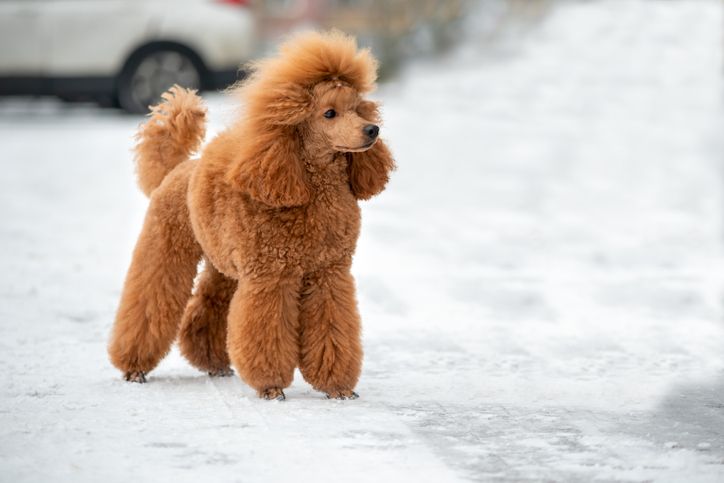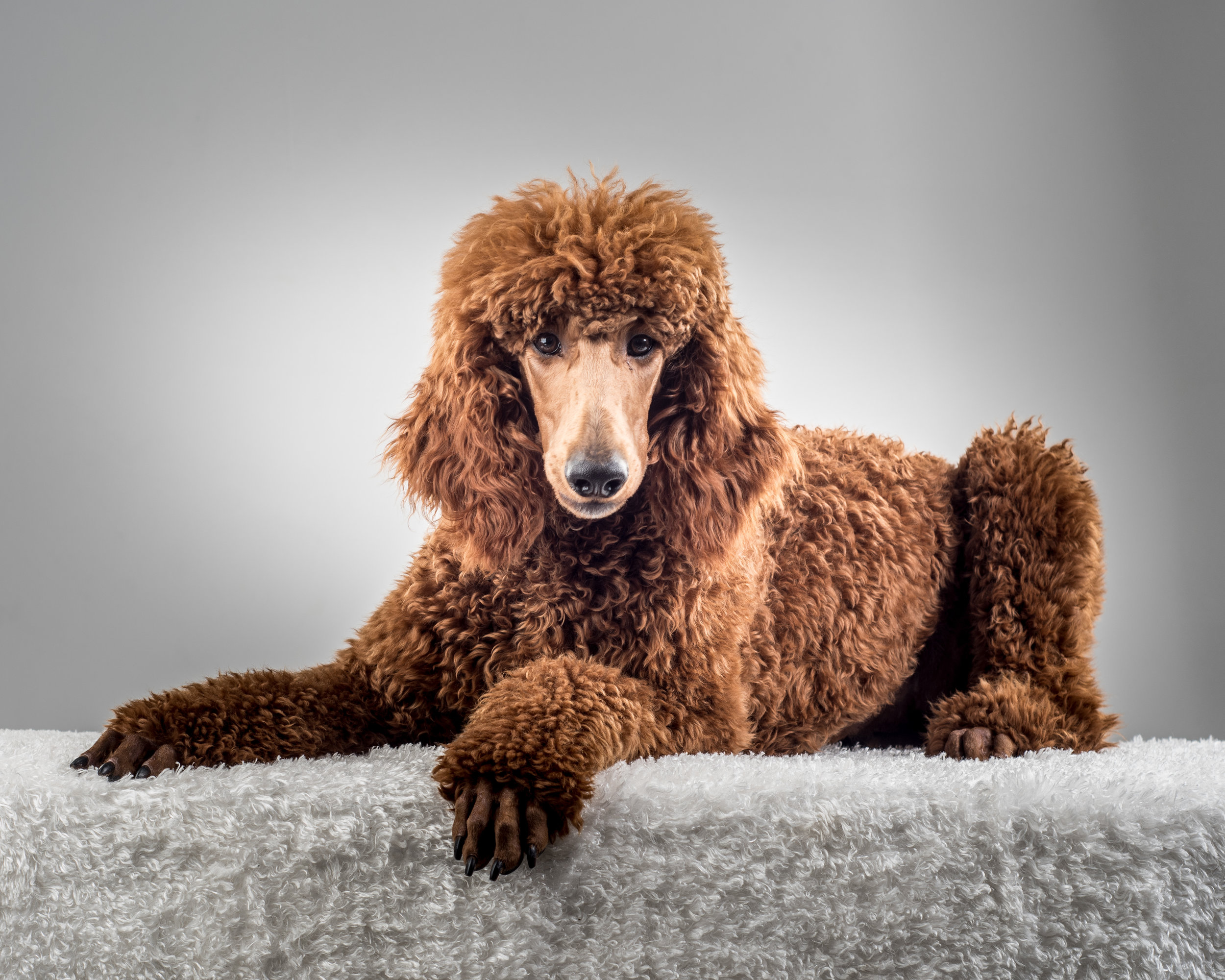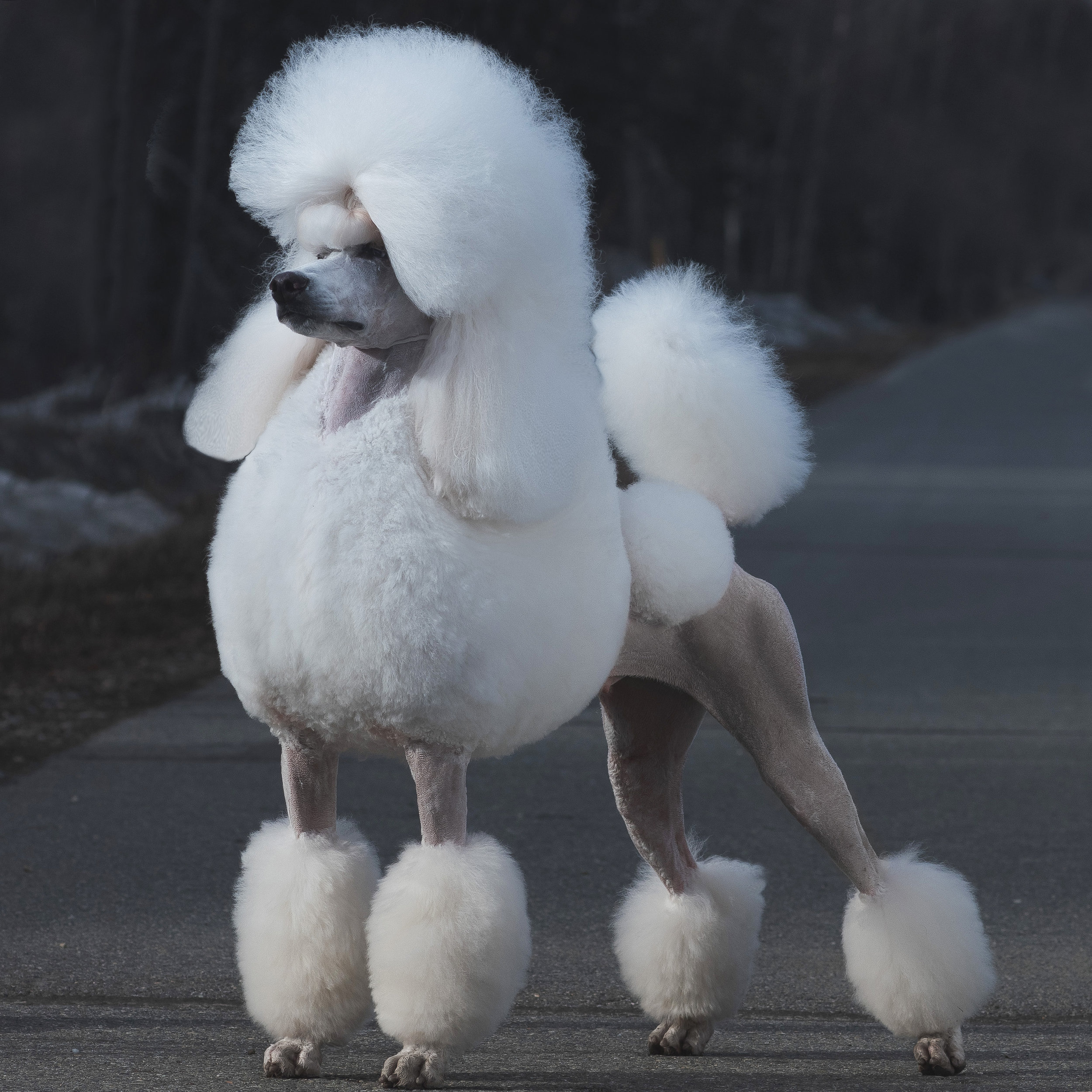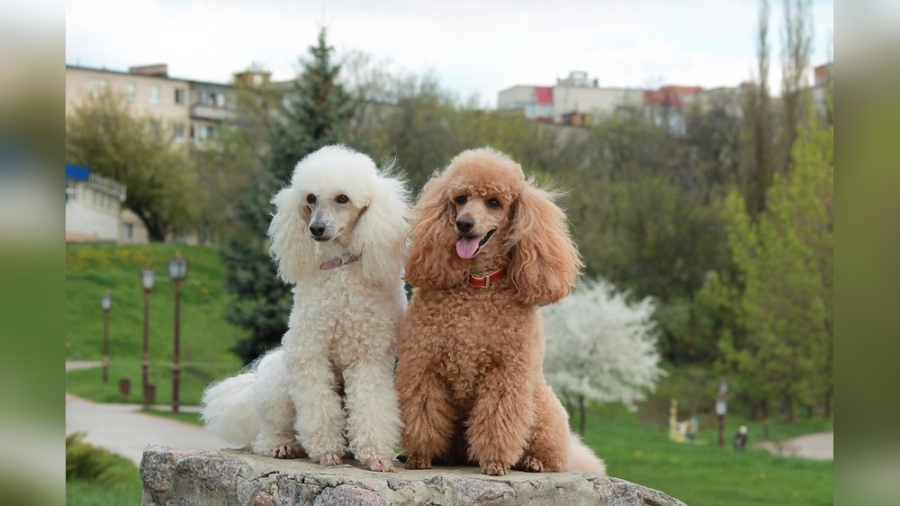Have you ever wondered if your poodle has hair or fur? It might seem like a small detail, but understanding this difference can change how you care for your furry friend.
Knowing whether your poodle has hair or fur affects everything from grooming routines to allergy management. If you want your poodle’s coat to look its best and stay healthy, this is information you don’t want to miss. Keep reading to discover what makes poodles unique and how their coat sets them apart from other dogs.
Poodles’ Coat Type
Poodles have a unique coat that sets them apart from many other dog breeds. Their coat is often mistaken for fur, but it is actually hair. This distinction matters for grooming, shedding, and allergy concerns.
The texture and growth cycle of poodle hair differ from typical dog fur. Understanding these differences helps poodle owners care for their pets better.
Poodles Have Hair, Not Fur
Poodles have hair because their coat grows continuously. Unlike fur, hair does not shed in large amounts. This means less mess and fewer allergens in the home.
Coat Texture And Appearance
Poodle hair is curly and dense. This texture helps trap dirt and water. It also gives poodles their classic fluffy look. The curls need regular grooming to prevent mats and tangles.
Grooming Needs For Poodle Hair
The continuous growth of poodle hair means regular trims are necessary. Grooming includes brushing and clipping every few weeks. This care keeps the coat healthy and comfortable for the dog.
Benefits Of Hair Over Fur
Poodles’ hair causes less allergic reaction in people. The low shedding reduces dander in the environment. Many allergy sufferers prefer poodles for this reason.
Hair Versus Fur
Understanding the difference between hair and fur helps explain why Poodles are unique. Their coat is often mistaken for fur but it is actually hair. This distinction affects grooming, shedding, and allergy concerns.
What Is Fur?
Fur is a dense coat that many animals have. It usually has two layers: a soft undercoat and a coarser topcoat. Fur grows to a certain length then falls out naturally. This process causes shedding, which can be heavy in some dog breeds.
What Is Hair?
Hair grows longer and does not shed like fur. It has a single layer without an undercoat. Hair keeps growing until it is cut or falls out due to damage. This means dogs with hair shed very little or not at all. Poodles belong to this group.
How Poodle Hair Differs From Fur
Poodles have curly, dense hair that grows continuously. They lack the undercoat common in furred dogs. This leads to less shedding and fewer allergens in the home. Their hair requires regular grooming to prevent mats and tangles.
Growth Cycle Differences
Poodles have hair that grows continuously in a long cycle, unlike fur, which sheds regularly. This slow growth means less shedding and fewer allergens. Their coat needs frequent grooming to stay healthy and tangle-free.
Understanding The Growth Cycle Of Poodle Hair
Poodles have hair, not fur. Their hair grows in a unique way.
The hair grows longer before it falls out. This is unlike fur, which has a short growth cycle.
This long growth cycle means less shedding. Poodles often shed very little or not at all.
Differences Between Hair And Fur Growth Cycles
Fur grows quickly but falls out in large amounts. It often has an undercoat that sheds seasonally.
Poodle hair grows slowly and continuously. It lacks a thick undercoat, so it does not shed much.
This slow growth means their coat needs regular trimming and grooming.
Impact On Grooming And Allergies
Because poodle hair grows longer, it can mat easily. Grooming helps keep the coat healthy and tangle-free.
The low shedding coat means fewer allergens in the home. This makes poodles a good choice for allergy sufferers.
Regular care is important to maintain the quality of their hair and skin.
Poodle Coat Texture
Poodles are well known for their unique coat texture. Their coats differ from many other dog breeds. Instead of fur, poodles have hair. This hair grows continuously and does not shed much. Understanding the texture helps in proper grooming and care.
Poodle Hair Vs Fur
Poodle hair is curly and dense. It forms tight loops that trap less dirt. Fur usually has a softer, fluffier feel. Fur also has an undercoat that sheds seasonally. Poodles lack this undercoat, which reduces shedding.
Curly And Dense Texture
The tight curls of poodle hair create a thick, wool-like coat. This texture helps protect them from cold and water. It also makes poodles look elegant and stylish. The curls need regular brushing to avoid mats and tangles.
Low Shedding And Allergies
Poodle hair sheds very little compared to fur. This makes poodles a popular choice for allergy sufferers. Less shedding means fewer allergens in the home. Their hair traps dander instead of releasing it freely.
Care For Poodle Hair
The hair requires frequent grooming. Regular trimming keeps the coat healthy and neat. Brushing prevents knots and removes loose hair. Bathing should be done carefully to maintain the hair’s natural oils.
Shedding Patterns
Poodles have unique shedding patterns compared to many other dog breeds. Their coat is made of hair, not fur, which means they shed very little. This trait makes poodles popular among people who prefer cleaner homes and have mild allergies.
Understanding how poodles shed helps owners manage grooming and maintain healthy coats. Their hair grows continuously, similar to human hair, instead of falling out in large amounts. This slow shedding cycle means less loose hair around the house and on furniture.
Minimal Shedding Throughout The Year
Poodles shed only a small amount all year round. They do not have a heavy shedding season like many dogs. This steady but low shedding helps keep homes cleaner and reduces allergy triggers.
Hair Growth Cycle And Shedding
Poodle hair grows in a cycle that lasts several months. After this period, hairs shed individually rather than in big patches. This gradual process differs from fur, which often falls out quickly and in bulk.
Impact Of Grooming On Shedding
Regular grooming reduces loose hairs and prevents mats. Brushing a poodle’s coat helps remove dead hairs before they fall out. Grooming also stimulates the skin and keeps hair healthy.

Hypoallergenic Qualities
Poodles are often praised for their hypoallergenic qualities. This trait makes them a popular choice for allergy sufferers. Unlike many dogs, poodles have hair instead of fur. This difference plays a key role in allergy reduction.
Hair grows continuously and sheds less than fur. Poodles do not have an undercoat, which often traps allergens. Their hair traps fewer dander particles, reducing airborne allergens.
Reduced Shedding Means Fewer Allergens
Poodles shed very little compared to furred dogs. Less shedding means less dander spreads in the home. Dander is a common trigger for allergies. By shedding less, poodles help keep allergen levels low.
Continuous Hair Growth And Grooming
Poodle hair grows in cycles and does not fall out quickly. This continuous growth means allergens stay trapped in the coat. Regular grooming removes loose hair and dander effectively. Grooming also keeps their coat clean and healthy.
Ideal For Allergy-prone Families
People with dog allergies often tolerate poodles better. Their hair causes fewer allergic reactions. Families can enjoy a loving pet without constant allergy symptoms. Choosing a poodle can improve quality of life for allergy sufferers.
Grooming Needs
Poodles have unique grooming needs because they have hair, not fur. Their hair grows continuously like human hair. It does not shed much, which helps reduce allergens. This trait makes grooming essential to keep their coat healthy and tangle-free.
Regular grooming prevents mats and keeps the poodle comfortable. Skipping grooming can cause painful knots and skin problems. Poodles need frequent care to maintain their stylish look and clean coat.
Brushing Frequency
Poodles require brushing at least three to four times a week. This keeps their hair smooth and stops tangles from forming. Use a slicker brush or comb to remove debris and loose hair gently.
Bathing Schedule
Bath poodles every three to six weeks depending on activity. Use mild dog shampoo to avoid drying out their skin. Regular baths keep their coat clean and soft but do not over-bathe to prevent irritation.
Professional Grooming
Take poodles to a professional groomer every six to eight weeks. Groomers trim and style their hair to maintain shape and hygiene. They also clean ears and trim nails, which are important for overall health.
Special Coat Care
Poodles need extra care around ears, paws, and face. These areas can easily collect dirt and mats. Use gentle tools and products to protect their sensitive skin and delicate hair.

Other Hair-coated Breeds
Many dog breeds have hair instead of fur. These breeds share similar coat traits with Poodles. Their hair grows longer and sheds less than fur. This makes them popular for allergy sufferers. Regular grooming is important to keep their coats healthy. These breeds often need trims and brushing to avoid mats. Here are some common hair-coated breeds to know.
Maltese
The Maltese has a silky, white coat that grows continuously. It lacks an undercoat, so it sheds very little. Their hair can grow very long if not trimmed. Maltese dogs require daily brushing to prevent tangles.
Shih Tzu
Shih Tzus have thick, flowing hair that needs regular care. Their coat can grow long and dense. They shed minimally due to the absence of an undercoat. Grooming helps keep their hair soft and clean.
Schnauzers
Schnauzers have a wiry, hair-like coat that grows steadily. This breed sheds less than furred dogs. They need regular trimming and hand-stripping for best appearance. Their coat protects them in many weather conditions.
Yorkshire Terriers
Yorkies feature long, silky hair similar to human hair. Their coat does not have an undercoat, reducing shedding. Yorkies require frequent grooming and brushing. Their hair can be styled in many ways.
Water Dogs
Spanish and Portuguese Water Dogs have curly, hair-like coats. These breeds shed very little and have low allergen levels. Their hair grows continuously and needs trimming. Regular grooming keeps their curls healthy and tidy.
Choosing Poodles For Allergies
Poodles are a popular choice for people with allergies. Their coat is different from most dogs. Instead of fur, poodles have hair. This makes a big difference for allergy sufferers.
Poodle hair grows continuously and does not shed like fur. Less shedding means fewer allergens in the home. Many allergy sufferers find poodles easier to live with. Still, no dog is 100% hypoallergenic.
How Poodle Hair Reduces Allergens
Poodles have hair that grows in tight curls. These curls trap dander and prevent it from spreading. Dander is a main cause of allergic reactions. Less loose dander means less chance of allergies flaring up.
Grooming Needs For Allergy Control
Regular grooming keeps poodle hair clean and healthy. Brushing removes loose hair and dander. Bathing also helps reduce allergens on the coat. Grooming every 4 to 6 weeks is ideal for poodles.
Choosing The Right Poodle Size
Poodles come in toy, miniature, and standard sizes. Smaller poodles produce less dander and hair. Toy and miniature poodles may be better for people with mild allergies. Standard poodles can also work but need more grooming.

Frequently Asked Questions
What Dog Breed Has Hair Instead Of Fur?
Breeds like Poodles, Maltese, Shih Tzus, Schnauzers, and Yorkshire Terriers have hair instead of fur. Their hair grows continuously and sheds less. This coat type often suits allergy sufferers and needs regular grooming to maintain health and appearance.
What Is The Difference Between Fur And Hair On A Dog?
Fur is shorter, denser, and sheds seasonally. Hair grows longer, sheds less, and requires regular grooming. Hair coats often cause fewer allergies.
What Happens If You Never Cut A Poodle’s Hair?
Neglecting to cut a Poodle’s hair causes severe matting, skin irritation, and discomfort. Their hair grows continuously and needs regular grooming. Without trims, mats can trap dirt and moisture, leading to infections and restricted movement. Regular haircuts keep Poodles healthy, comfortable, and clean.
Do Poodles Shed Or Smell?
Poodles have hair, not fur, so they shed very little. Their coat requires regular grooming to prevent odor and matting. Proper care keeps poodles smelling fresh and clean.
Conclusion
Poodles have hair, not fur, which grows continuously. Their hair sheds less, causing fewer allergies. Regular grooming keeps their coat healthy and neat. Understanding this helps owners care for poodles better. Hair makes poodles unique among many dog breeds. Choosing a poodle means less shedding to manage.
Their coat needs gentle brushing to avoid mats. Now you know why poodles require special care. This knowledge supports happy, healthy poodle companions.

